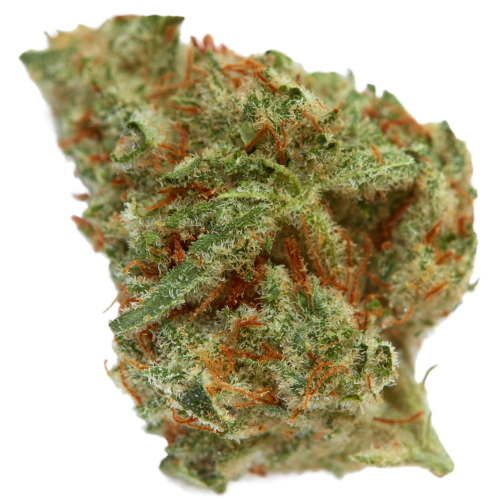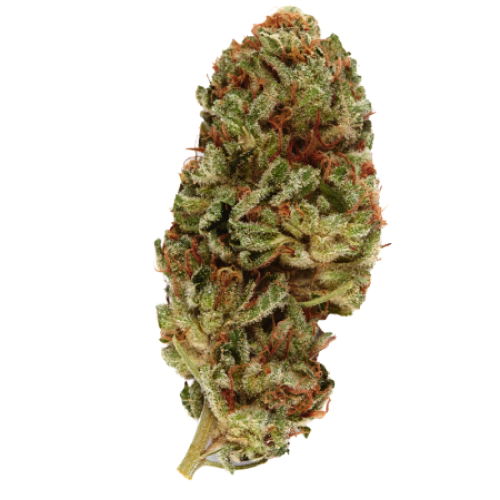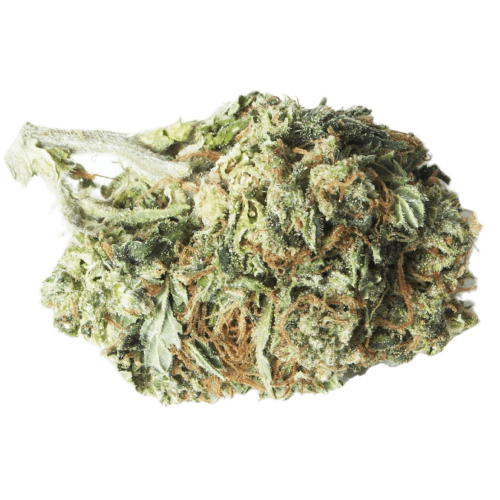Afghan Goo
Cannabinoid THC Dominant
THC 20 - 25%
CBD 6 - 6.15%
Effect Sleepy
Side Effect Dry eyes
Flavor Pine
Afghan Goo Strain Information
THC
CBD
Potency
Afghan Goo is an Indica-dominant weed strain. This phenotype has been created for veteran smokers because its THC level is quite impressive – 20-25%, depending on the batch and the breeder. This plant has the ability to retain cannabidiol, so its CBD amount is also outstanding, with the highest recorded content of 6-6.15%.
Smells, Tastes, and Terpenes
The smell delivered by the Afghan Goo strain mimics pine and sage because the plant is abundant in bisabolol. There are also some nutty notes brought by limonene. These scents intensify as the nugs are burnt. On the exhale, smokers can notice a sweet flavor characteristic of pinene.
Medical Uses and Effects of Afghan Goo
The high brought by this cannabis comes on pretty quickly and fills smokers with a giggly euphoria that improves their spirits and uplifts their mood. They feel happy and at ease. Then, their bodies fall off into complete relaxation. Users who are not careful with the dose may be left sleepy.
The combination of the high THC content with the increased CBD percentage is very beneficial for MMJ patients. People who try to fight with the following medical conditions report huge success:
- Attention-deficit/hyperactivity disorder
- Migraines
- Lack of appetite
- Arthritis
- Depression
Bear in mind that potent marijuana strains like Afghan Goo may cause adverse effects in sensitive consumers, so be mindful of the dose. Potential unwanted reactions include:
- Dry eyes
- Thirst and dry mouth
- Fatigue
- Concern
- Drowsiness
- Dizziness
- Slurred speech
- Panic attacks
Tips for Growers
When properly cultivated, the plants reach a flowering period in 55-64 days. The height of plants can be 30’’-60’’ for indoor gardens and 60’’-80’’ for herbs grown outside. In 60 days, gardeners can expect them to harvest (1-2 oz./ft2). The nugs developed by the Afghan Goo strain are spade-shaped coated by lots of sticky syrupy resin.
Side Effects
Simply let us know how this strain tastes or write a detailed review.
Afghan Goo Strain Cannabinoids
| THC | Tetrahydrocannabinol, or THC, is a major cannabis chemical compound. It is a psychoactive element that stimulates dopamine release and induces euphoria or happiness. THC-rich strains may be helpful with such conditions as lack of appetite, chronic pains , etc. It is considered to be the primary active marijuana component. | 20 - 25% |
| CBD | Cannabidiol, or CBD, is a major compound in cannabis, which is non-psychoactive. It is also proved to counteract the side effects of the second major component THC. CBD is widely used for medicinal purposes in rubs, oils and so on. It is helpful in muscle pain cases, may treat arthritis and migraines. Even Greeks used it against pain, while Queen Victoria applied it to get rid of menstrual cramps. | 6 - 6.15% |
| CBC | Cannabichromene, or CBC, is a minor cannabinoid, meaning that its quantity in cannabis is quite little. Though it has the same origin as CBD and THC, it is different in functions. Without any psychoactive effects, it is an efficient cannabis compound in combating acne and depression. CBC produces analgesic, antibacterial and anti-inflammatory effects. | 0.13 - 0.27% |
| CBG | Cannabigerol, or CBG, is one of the minor cannabis compounds in adult plants. On the other hand, young ones contain a lot of this antibacterial and anti-inflammatory component. During the growth, CBG is converted into different cannabinoids, mostly THC and CBD. The compound itself increases appetite and decreases eye pressure. | 0.61 - 0.67% |
| CBN | Cannabinol, or CBN, is a trace element in cannabis that is considered to be mildly psychoactive. It appears from oxidation THC, exposed to light and heat. CBN is mostly contained in old cannabis and in traditional hashish. It is effective against insomnia, bacterial infections and appetite loss. | 0.02 - 0.25% |
| THCV | Tetrahydrocannabivarin, or THC-V, is a compound contained in cannabis in trace amounts. Even though it is close to THC molecularly, it is different in effects. This compound may be psychoactive only in large amounts. THC-V reduces blood sugar, controls appetite, stimulates bone growth, etc. African Sativa strains are the richest in THC-V. | 0.05 - 0.26% |
Afghan Goo Terpene Profile
| Pinene | Pinene is one of the most widespread terpenes in nature, found in pine trees, basil, nutmeg, parsley, and rosemary. Cannabis containing terpene (alpha-pinene or α-pinene) boasts a strong pine scent. Pinene is responsible for anti-inflammatory, pain-relieving, and anti-anxiety effects. | 0.15% |
| Humulene | Humulene (also known as α-humulene) is one of the major terpenes found in cannabis, contributing to woody, earthy, spicy, herbaceous, and, mainly, floral aromas of cannabis. Used in modern medicine, humulene offers anti-inflammatory, antibacterial, and appetite suppressant effects, which have been well-researched by pharmaceutical companies. | 0.11% |
| Limonene | Limonene (also known as d-limonene) is the second most common terpene in nature and the third most common terpene in cannabis. It has a powerful citrus aroma and can be found in all citruses, including lemons, oranges, grapefruits, limes, juniper, etc. Limonene is known to elevate moods and provide anxiety, depression, and stress relief. | 0.17% |
| Linalool | Linalool (also known as beta linalool, linalyl alcohol, linaloyl oxide, and p-linalool) is one of the rarest terpenes found in cannabis, mostly in small quantities. Linalool is known for its spicy and lavender aroma, bringing relaxation and calming effects. It is also said to provide anti-inflammatory and analgesic properties that can be useful for athletes. | 0.09% |
| Bisabolol | Bisabolol (also known as α-Bisabolol or levomenol) is a lesser-known terpene found in cannabis. It contributes to anti-inflammatory, anti-irritant, antioxidant, anti-microbial, and analgesic properties of weed strains containing bisanol. Attentive smokers would be able to catch a nutty, fruity scent with herbal and floral undertones, with a tender trace of coconut. | 0.15% |
| Terpinolene | Terpinolene is one of the most common terpenes found in cannabis; however, It's usually presented in small quantities. Is responsible for piney, floral, herbaceous, and even a little bit citrusy aroma of cannabis. Terpinolene can be found in lilacs, nutmeg, and cumin. In cannabis, terpinolene contributes to the sensation of "freshness." Has the potential to reduce the risk of heart diseases. | 0.11% |
| Phellandrene | Phellandrene (also known as alpha- and beta-phellandrene) is one of the rare terpenes found in cannabis with antihyperalgesic and antidepressive properties. Phellandrene contributes to a minty, woody, and mildly citrus aroma in cannabis. Previously confused with limonene and pinene, phellandrene was eventually distinguished as a separate terpene common for eucalyptus. Also, it could be found in mint, dill, black pepper, cinnamon, parsley, pine, and lavender. | 0.08% |
| Caryophyllene | Caryophyllene (also known as beta or b caryophyllene) is a terpene found in many herbs and spices, such as black pepper, basil, rosemary, and oregano. Cannabis high in caryophyllene delivers a strong spicy, peppery aroma, resembling cinnamon and cloves. Caryophyllene offers potent anti-inflammatory and sedative effects. | 0.13% |
| Total terpenes content | 0.99% |
Growing Info
Similar Strains
THC 17 - 17%
CBD 0.1 - 0.3%
Effect Sleepy
Flavor Grapefruit
THC 18 - 18%
CBD 0.05 - 0.25%
Effect Tingly
Flavor Chemical
THC 20 - 23%
CBD 0.66 - 0.79%
Effect Happy
Flavor Butter
THC 18.8 - 21.8%
CBD 0.37 - 0.62%
Effect Happy
Flavor Citrus
THC 16 - 18.5%
CBD 0.47 - 0.66%
Effect Happy
Flavor Sweet
THC 22.5 - 24.5%
CBD 0.44 - 0.5%
Effect Relaxed
Flavor Rose

THC 21 - 23.75%
CBD 0.24 - 0.58%
Effect Sleepy
Flavor Citrus
THC 17 - 27%
CBD 0.87 - 1.09%
Effect Relaxed
Flavor Spicyherbal
THC 18.17 - 20.83%
CBD 0.41 - 0.61%
Effect Tingly
Flavor Spicyherbal
THC 10.75 - 13.06%
CBD 0.15 - 0.36%
Effect Uplifted
Flavor Coffee
THC 16 - 19%
CBD 0.57 - 1.09%
Effect Concentrated
Flavor Plum










Be the first and share your opinion
Write a Review